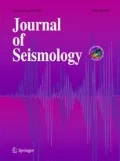Abstract
Microseismicity variations in space and time due to pore pressure changes in an inhomogeneous permeable sample are considered. The analysis is based on laboratory experiments performed to study the relation between acoustic emission (which corresponds to microseismic events in real scale) and pore pressure changes due to water injection into, or release from, a porous sample under load. The study showed not only some characteristics of microseismicity variations during non-stationary fluid flow but also the possibility to solve the inverse problem of estimating local permeability from variations of microseismic activity in a particular volume of the porous medium.








Similar content being viewed by others
References
Adushkin VV, Rodionov VN, Turuntaev SB, Yudin AE (2000) Seismicity in the oil field. Oilfield Rev Schlumberger 12(2):2–17
Brown ET (ed) (1981) Rock characterization, testing and monitoring, ISRM suggested methods. Pergamon, Oxford
Delépine N, Cuenot N, Rothert E, Parotidis M, Rentsch S, Shapiro S (2004) Characterization of fluid transport properties of the Hot Dry Rock reservoir Soultz-2000 using induced microseismicity. J Geophys Eng 1:77–83
Eisner L, Williams-Stroud S, Hill A, Duncan P, Thornton M (2010) Beyond the dots in the box: microseismicity-constrained fracture models for reservoir simulation. Leading Edge 3:326–333
Fisher T, Guest A (2011) Shear and tensile earthquakes caused by fluid injection. Geoph Res Let 38:L05307, 4 pp. doi:10.1029/2010GL045447
Grasso J-R (1992) Mechanics of seismic instabilities induced by the recovery of hydrocarbons. PAGEOPH 139(3/4):507–534
Grechka V, Mazumdar P, Shapiro SA (2010) Predicting permeability and gas production of hydraulically fractured tight sands from microseismic data. Geophysics 75(1):B1–B10
Kuznetsov VM, Faddeenkov NN (1975) Fragmentation schemes. Combust Explosion Shock Waves 11:541–548. doi:10.1007/BF00744924
Maxwell S (2010) Microseismic: growth born from success. Leading Edge 3:338–343
Nikolaevsky VN (1990) Mechanics of porous and fractured media. World Scientific, Singapore
Rothert E, Shapiro SA (2007) Statistics of fracture strength and fluid-induced microseismicity. J Geophys Res 112:B04309. doi:10.1029/2005JB003959
Schelkatchev VN (1995) Fundamentals and applications of nonstationary filtration theory. Neft i gaz, Moscow, In Russian
Shapiro SA, Rentsch S, Rothert E (2005) Characterization of hydraulic properties of rocks using probability of fluid-induced microearthquakes. Geophysics 70:F27–F34
Shapiro SA, Rothert E, Rath V, Rindschwentner J (2002) Characterization of fluid transport properties of reservoirs using induced microseismicity. Geophysics 67:212–220
Simpson DW (1986) Triggered earthquakes. Annu Rev Earth Planet Sci Paolo Alto Calif 14:21–42
Stanchits S, Backers T, Stephansson O & Dresen G (2003) Acoustic emissions and micromechanics of granite from tensile (mode I) and shear (mode II) loading. In: Proc. EUROConference on Rock Physics and Geomechanics. September 2003, Netherlands
Sultanov SA (1974) Monitoring of oil stratum water flooding. Nedra, Moscow (In Russian)
Sze EKM, Toksoz MN, Burns DR and Mueller GF (2005) Characterization of induced seismicity in petroleum reservoir: a case study. In: EAGE 67th Conference & Exhibition, Madrid, Spain, 13–16 June 2005
Tsvetkov VM, Lukishov BG, Livshits LD (1979) Fragment formation in crushing a brittle medium under hydrostatic compression. J Min Sci 15(3):228–232. doi:10.1007/BF02539986
Zoback M, Zinke J (2002) Production-induced normal faulting in the Valhall and Ekofisk oil fields. Pure Appl Geophys 159:403–420
Acknowledgments
The authors wish to acknowledge the generous support of Russian Foundation for Basic Research (RFBR project # 10-05-00638), Christian Besson for his valuable comments, and the reviewers of the manuscript for their suggestions.
Author information
Authors and Affiliations
Corresponding author
Rights and permissions
About this article
Cite this article
Turuntaev, S.B., Eremeeva, E.I. & Zenchenko, E.V. Laboratory study of microseismicity spreading due to pore pressure change. J Seismol 17, 137–145 (2013). https://doi.org/10.1007/s10950-012-9303-x
Received:
Accepted:
Published:
Issue Date:
DOI: https://doi.org/10.1007/s10950-012-9303-x




